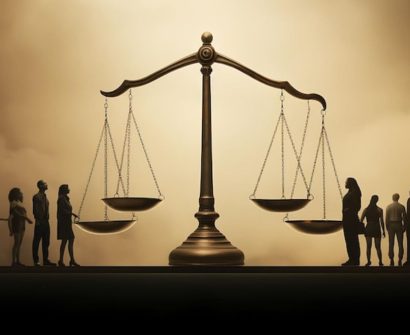
Riots serve as conspicuous reminders of hidden tensions and grievances throughout society. These episodes of collective rage frequently end in chaos, destruction, and deaths. To tackle the root causes of riots, stop them from occurring again, and make sure victims obtain justice, it is essential to understand the riots from a legal perspective. The Indian Penal Code (IPC) is an important tool for categorizing and prosecuting offenses associated with riots in India.
riot: About
- Rioting is the term used to describe an offense done by a group of people or by any individual who is a member of that group. The presence of five or more people is required for rioting.
- This offense typically involves abrupt and provocative behaviour and is rooted in civil unrest.
- It demonstrates a herd mentality, which is why even if a member of the guilty group hasn’t done anything violent, they will still be held accountable for rioting.
- A similar goal and purpose of committing a crime is one of the most crucial components of rioting.
- Because of their “common intention,” all members of the group are subject to punishment even if they did not engage in rioting.
section 146 ipc
- riot: Every member of an unlawful assembly is guilty of rioting if force or violence is employed by the assembly, or by any of its members, to further the assembly’s shared goal.
section 147 of ipc
- punishment for rioting in ipc: According to Section 147 of the Indian Penal Code, anyone found guilty of rioting faces a maximum sentence of two years in prison, a fine, or both. Bailable, cognizable, and non-compoundable offenses include Section 147.
riot in ipc: Essential Ingredients
In accordance with Section 147 of the Indian Penal Code, the following conditions must be met in order to prosecute someone for the offense of rioting:
- It must contain the phrase “illegal assembly,” as defined in section 141 of the code.
- The accused must gather at least five persons in an unlawful assembly.
- The defendant had to have taken part in the illegal assembly as stipulated in the code’s section 142.
- Force or violence must be used by the unlawful gathering or any individual inside it.
- The force or violence must be used to further the common objective of the purportedly unlawful assembly.
riot under ipc: Punishment for Provoking
- According to Section 153 of the Indian Penal Code, anyone who intentionally or maliciously provokes someone by engaging in any illegal activity with the intent or knowledge that such provocation will likely result in the commission of an offence, such as rioting, faces punishment of either type of imprisonment for a term that may extend to one year, fine, or both; if no offence is committed, punishment of either type of imprisonment for a term that may extend to six months, fine, or both.
riot in ipc: Case Laws
- In the case of Maiku v State of Uttar Pradesh, a police sub-inspector and several constables apprehended someone while the sub-inspector was investigating a case. The individual who was arrested willingly guided the authorities to the location in order to retrieve the deceased, but they were caught in the act of running away. After being beaten, he was ultimately vanquished and slain.
The Court decided that the police were there to carry out an investigation. As such, their common objective was legitimate. Rioting does not occur when any assembly member uses force as long as the group’s objective is legal.
- In the case of Vijay Singh Mankotia v State of Himachal Pradesh, more than 200 people came together as part of a political party’s “dharna” against the government on a public thoroughfare. As a result, other people who were meant to use the highway were wrongfully detained.
The Himachal Pradesh High Court declared it to be public disruption and rioting. It was deduced at the outset that the petitioners had committed offenses defined by Section 147 of the IPC.
The section explains each advantage provided by this clause as well as the Indian Penal Code’s definition of rioting and associated penalties. Section 147 of the IPC states that rioters may receive a term of two years in prison, a fine, or both based on the type and degree of damage they caused.
Effective riot management and prevention depend on identifying and addressing their underlying causes, fostering peace within the community, and ensuring prompt and equitable legal proceedings. Moreover, the cultivation of comprehension and acceptance among heterogeneous factions is vital for enduring tranquility and concord in the community, underscoring the necessity of judicial actions in conjunction with educational initiatives to counteract violence.
Riot FAQs
- What are the essentials of rioting?
The unlawful assembly or any of its members utilized force or violence against them, and the violence was employed to further their common (illegal aim). They were motivated by a common unlawful object.
- What is the punishment for rioting?
A conviction for rioting carries a maximum sentence of two years in any type of jail, a fine, or both.
- When an unlawful assembly becomes a riot?
Every member of an unlawful assembly is guilty of rioting if force or violence is employed by the assembly, or by any of its members, to further the assembly’s shared goal.
- What is the difference between unlawful assembly and rioting?
With a slight distinction that involves the use of force, rioting is similar to unlawful assembly; therefore, five or more individuals must be present, just as in the case of unlawful assembly.
- What is riot common purpose?
A riot is characterised as a gathering of twelve or more individuals who, for a common goal, used or threatened to use unlawful violence, and whose behaviour was such that a person there with reasonable firmness would worry for their own safety.
- What is the IPC section for rioting?
Every member of an unlawful assembly is guilty of rioting whenever force or violence is employed by the assembly or any of its members to further the assembly’s shared goal. (The Indian Penal Code, Section 146).
- What is riot situation?
It is defined as a violent disruption of the peace in public by three or more people gathered for a mutually exclusive goal. The rioters believe they have a significant role to play in influencing the government’s social, political, and economic policies.
- What are riot victims?
An individual or group of people who have been harmed physically, psychologically, or materially as a result of a riot is referred to as riot victims.
- Which Online rjs coaching is best for RJS preparation?
The reputable Jaipur Online rjs coaching program “Jyoti Judiciary Coaching” aids students in getting ready for the RJS exam. A systematic approach to RJS test preparation is made possible by Jyoti Judiciary, the top offline and online RJS coaching program in Jaipur. Their curriculum has been carefully designed to cover all the subjects and courses required for passing the Rajasthan Judicial Service Examinations.
- Which coaching is best for judiciary?
The most effective judiciary coaching in Jaipur is provided by Jyoti Judiciary Coaching. The objective is to create a comfortable learning environment for the students. It makes the difficult task seem easy, which increases the likelihood of achieving the desired outcome. The objective at Jyoti Judiciary is to give students the best possible education possible. The Institute pledges to use every resource at its disposal to provide you with the finest preparation for the Judicial Services entrance examinations.
With the goal of giving students the best coaching available for law entrance exams including the CLAT, AILET, and various other numerous state judiciary exams, Jyoti Judiciary Coaching, India’s Finest educational Platform, was established. Come enrol now with Jyoti Judiciary!
For any latest news, legal topics, judiciary exams notifications, patterns, etc watch Jyoti Judiciary’s YouTube channel for legal videos for any updates at https://youtube.com/@jyotijudiciarycoaching4852?si=2cwubh9d2A9urwJf










